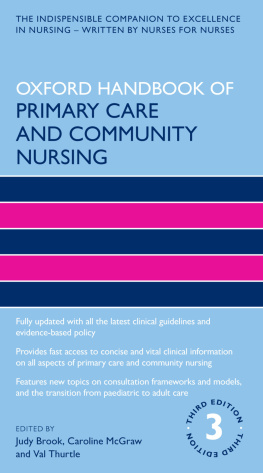Elizabeth C. Arnold, PhD, RN, PMHCNS-BC
Associate Professor Emeritus, College of Health and Human Services, University of North Carolina Charlotte, Charlotte, North Carolina
Copyright


INTERPERSONAL RELATIONSHIPS: PROFESSIONAL COMMUNICATION SKILLS FOR NURSES, SIXTH EDITION
ISBN: 978-1-4377-0944-5
Copyright 2011, 2007, 2003, 1999, 1995, 1989 by Saunders, an imprint of Elsevier Inc.
No part of this publication may be reproduced or transmitted in any form or by any means, electronic or mechanical, including photocopying, recording, or any information storage and retrieval system, without permission in writing from the publisher. Details on how to seek permission, further information about the Publishers permissions policies and our arrangements with organizations such as the Copyright Clearance Center and the Copyright Licensing Agency, can be found at our website: www.elsevier.com/permissions.
This book and the individual contributions contained in it are protected under copyright by the Publisher (other than as may be noted herein).
Notices
Knowledge and best practice in this field are constantly changing. As new research and experience broaden our understanding, changes in research methods, professional practices, or medical treatment may become necessary.
Practitioners and researchers must always rely on their own experience and knowledge in evaluating and using any information, methods, compounds, or experiments described herein. In using such information or methods they should be mindful of their own safety and the safety of others, including parties for whom they have a professional responsibility.
With respect to any drug or pharmaceutical products identified, readers are advised to check the most current information provided (i) on procedures featured or (ii) by the manufacturer of each product to be administered, to verify the recommended dose or formula, the method and duration of administration, and contraindications. It is the responsibility of practitioners, relying on their own experience and knowledge of their patients, to make diagnoses, to determine dosages and the best treatment for each individual patient, and to take all appropriate safety precautions.
To the fullest extent of the law, neither the Publisher nor the authors, contributors, or editors, assume any liability for any injury and/or damage to persons or property as a matter of products liability, negligence or otherwise, or from any use or operation of any methods, products, instructions, or ideas contained in the material herein.
International Standard Book Number: 978-1-4377-0944-5
Managing Editors: Jean Fornango and Michele D. Hayden
Developmental Editors: Maria Broeker and Heather D. Bays
Publishing Services Manager: Deborah Vogel
Design Direction: Kim Denando
Printed in the United States of America
Last digit is the print number: 9 8 7 6 5 4 3 2 1 
Dedication
To Jacob D. Goering, PhD
His influence on my life as an educator and clinician was life changing and long lasting.
Elizabeth C. Arnold
In Memoriam, Richard Daniel Underman, beloved brother.
Kathleen Underman Boggs
Acknowledgments
This sixth edition of Interpersonal Relationships: Professional Communication Skills for Nurses continues to reflect the ideas and commitment of our students, valued colleagues, clients, and the editorial staff at Elsevier. As noted in earlier editions, the origin of the text began in conjunction with the development of an interpersonal relationship seminar at the University of Maryland School of Nursing. This seminar was designed by faculty to facilitate understanding of therapeutic communication across clinical settings through experiential simulations. Developing effective communication was important then, and it remains central to effective clinical practice in contemporary health care. The vitality of its contents reflects the commitment of faculty and students from many nursing programs and clinical nurses who have deepened the understanding of the materials presented in this text through their positive support, ideas, and constructive feedback. Their voices still find consistent expression in each chapter of this revision.
); and David R. Langford, RN, DSNc, from the University of North Carolina Charlotte.
This book is the result of the unique team effort of several talented developmental editors who worked hard to make the process of revision as seamless as possible. We are most grateful for their expertise and commitment to the completion of this book. Each went out of her way to make the revision a positive, quality experience. Tiffany Trautwein worked with us during the first part of the preparation for this edition. Maria Broeker stepped in during the next phase of the text, and Heather D. Bays worked with us to finish the book in the final phase of the project. Maria Broeker deserves special acknowledgment for her dedication to the preparation of this book. Her support and encouragement have been invaluable. We also express our appreciation to Jeff Somers from Graphic World Publishing Services, who coordinated the final production of this book for publication, and to Jeanne Robertson for the revised artwork in this edition.
Finally, we acknowledge the loving support of our families and Michael J. Boggs for their unflagging support and encouragement.
Elizabeth C. Arnold and Kathleen Underman Boggs
Preface
Recognition of the importance of therapeutic communication and professional relationships with clients and families as a primary means of achieving treatment goals in health care continues to be the underlying theme in Interpersonal Relationships: Professional Communication Skills for Nurses. This sixth edition has been thoroughly revised, rewritten, and updated to meet the challenge of continuing to serve as a primary communication resource for nursing students and professional nurses. Although the content, exercises, and case examples continue to be written in terms of nurse-client relationships, they are applicable to clinical practice relationships conducted by other health care providers. This edition, like previous editions can be used as individual teaching modules, as a primary text, or as a communication resource integrated across the curriculum. Two new chapters related to communication strategies for client safety, and contemporary realities in continuity of care reflect the latest applications of communication in contemporary health care delivery.
, Role Relationship Patterns, establishes a framework for considering the issues surrounding new models of nursing education and explores role relationships as a nursing diagnosis. This section ends with a comprehensive discussion about palliative care and communication strategies in end-of-life care. Part III, Therapeutic Communication, explores basic concepts of therapeutic communication and applications of strategies nurses can use with different population groups: culturally diverse, family, and group communication. Applying therapeutic communication strategies in conflict situations and special attention to health promotion community strategies and health teaching complete this section. Part IV, Responding to Special Needs, focuses on the special communication needs of children, older adults, clients with communication deficits, and those experiencing stress or crisis. Part V, Professional Communication, describes communication issues with other health professionals and nursing applications in the use of electronic health records with accompanying taxonomies. Two new chapters address issues in contemporary health care related to the role of communication in promoting safety in the health care environment and principles related to supporting continuity of care within and across care settings. Major changes in managing health care data and transmitting vital health information including the place of the Internet for continual transmission of information in real time are addressed. The role of electronic communication as an increasingly important form of communication is highlighted at point of care and across clinical settings.






